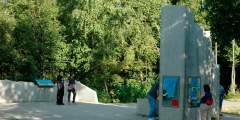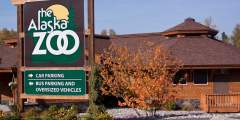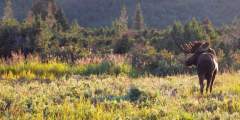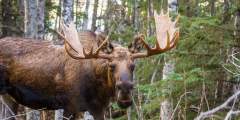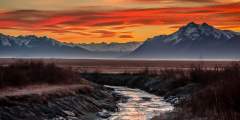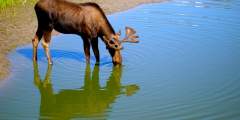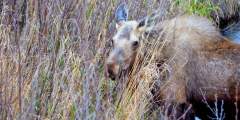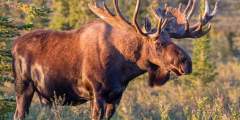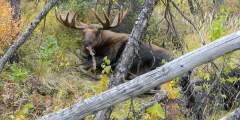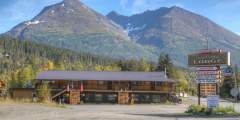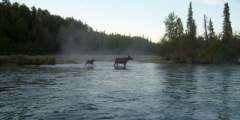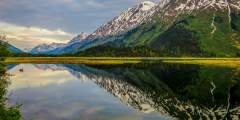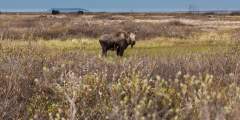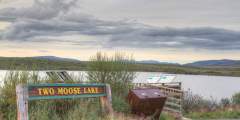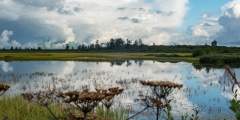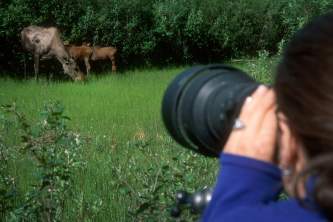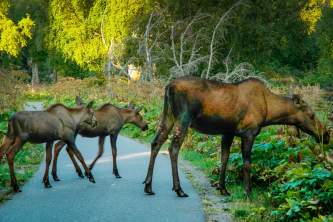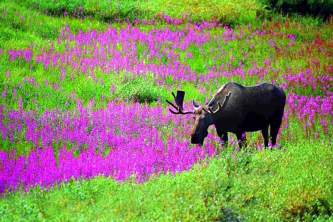The Best Moose Viewing Spots in Alaska
A great nickname for Alaska might be “Moose World.” These gangly, bulbous-nosed browsers with a cranky reputation—ranging from shy 800-pound cows to 1,600-pound bulls with majestic antlers—are relatively easy to see throughout the mainland. They are probably Alaska’s most-often viewed large mammal, fascinating to residents both as a food source (via hunting) and an icon of the natural world.
Tip: They Can Show Up Almost Anyplace!
When they’re not bedded down for a snooze, moose spend their days strolling through wooded and brushy areas looking for food. They are often alone. Seeing one on the move—particularly during summer or inside an urban greenbelt—depends a bit on luck. Don’t give up!
How to Improve Your Chances:
- During summer, visit edge habitat along wetlands or water bodies both early and late—think sunrise and dusk—when moose are most active.
- During winter, moose eat willow and birch, and favor areas where wind has blown snow away. Look for stands of stunted trees that have been browsed and well-trod paths dotted with round “moose pellets” (their wood-based winter poop.)
Popular spots
Jump to: MAP | Potter Marsh | Kincaid Park | Chugach State Park | Portage Valley | Tern Lake | Kenai River Estuary | Palmer Hay Flats | Denali National Park | Chena River Valley | Off-The-Beaten Track | Nome & the Seward Peninsula | Guaranteed Moose Viewing | Viewing Tips
Potter Marsh (the Anchorage Coastal Wildlife Refuge)
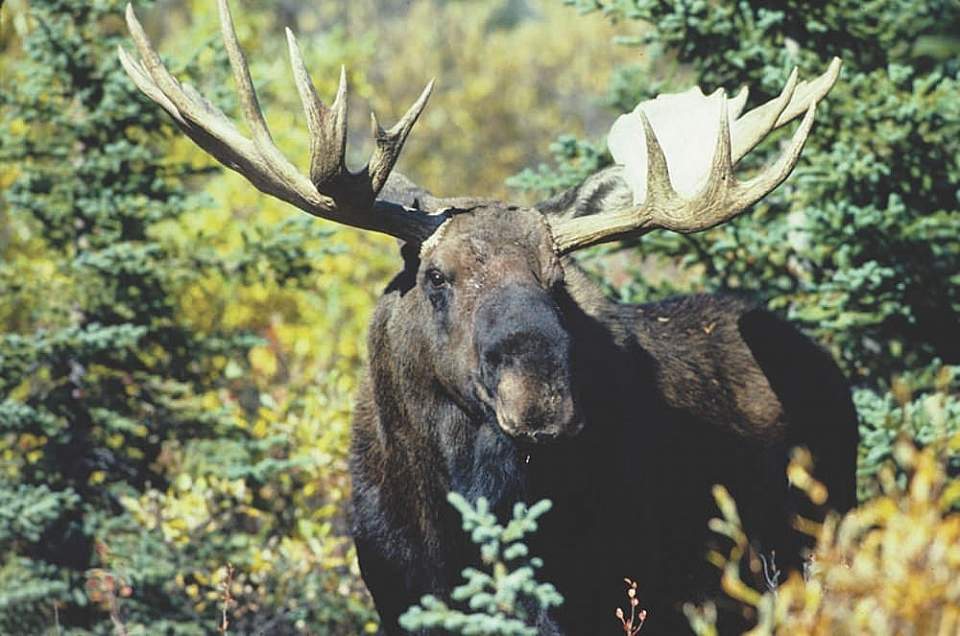
Huge moose make for spectacular sightings in the Alaskan wilderness
20 minutes south of downtown Anchorage
Moose can be spotted frequently in and around Potter Marsh, a 564-acre fresh pond and wetland complex that stretches for nearly two miles between the New Seward Highway and the base of the Chugach Mountains.
Kincaid Park
15 minutes from downtown Anchorage at the end of Raspberry Road
Moose thrive in the open birch-spruce forest and willow thickets of Kincaid Park in the southwestern corner of the Anchorage peninsula. With more than 70 miles of trails crisscrossing its rugged 1,500 acres, Kincaid makes it easy for people to get deep into the woods where moose hang out. It has a solid reputation as one of the mostly likely places in Anchorage to see a moose on purpose, even during summer when the animals tend to seek out jungled greenery.
Powerline Pass Trail of Chugach State Park
An easy half-mile hike from the Glen Alps Trailhead
In one of the most extraordinary wildlife spectacles in Alaska, dozens of moose converge on the brushy upper valley of the South Fork of Campbell Creek every fall during moose-mating season. This annual rut draws an amazing number of these large animals into the open, with 20 to 30 antlered bulls and cows often mingling within sight of easy walking just about any day in September and October. It’s this no-fuss access that makes the phenomenon so remarkable.
Portage Valley and the head of Turnagain Arm
An hour southeast of Anchorage down the Seward Highway
Moose find river valleys and wetlands irresistible, drawn by the lush greenery during summer and the woody browse during winter. The Twentymile and Placer river valleys reach for miles into open country visible from the Seward Highway at the head of Turnagain Arm. Portage Valley—extending about five miles east of the Seward Highway to the shore of Portage Glacier Lake—is full of prime moose habitat that’s easy to view.
Tern Lake
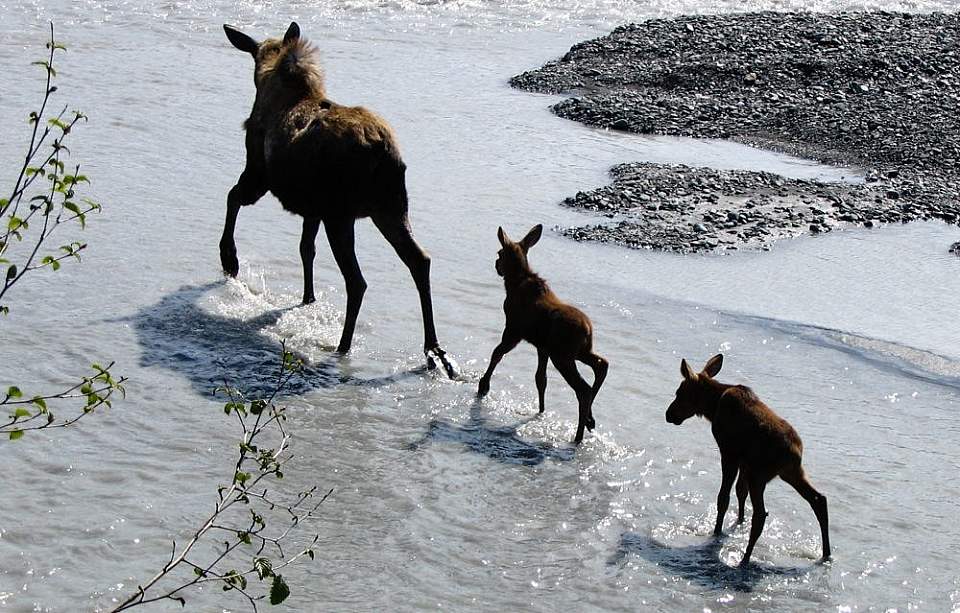
Moose with her calves on Outwash Plain
About 2 hours south of Anchorage or half hour east of Seward
Wildlife regularly converges on this shallow and very productive lake surrounded by big, open slopes in the heart of the Kenai Mountains. Famous for attracting waterfowl and migrating birds—Arctic terns, trumpeter swans, mew gulls—Tern Lake also draws moose to the boundaries between meadows and forest, especially early and late in the day. Sweeping, unobstructed views of the shoreline make viewing especially productive.
Kenai River Estuary
About two hours south of Anchorage via Seward and Sterling highways
The Kenai River meanders through a sweeping salt marsh and wetland on its final five-mile journey to its mouth on Cook Inlet. While more well known for its immense flocks of migrating birds and the presence of a small herd of caribou, the estuary also draws moose into the open.
Palmer Hay Flats State Game Refuge
About 40 minutes north of Anchorage up the Glenn Highway
Moose regularly congregate in this immense, brushy wetland that sprawls at the head of Knik Arm in the mouth of the Matanuska Valley, about 30 to 35 miles north of Anchorage. The 28,000-acre refuge—extending west from where the Glenn Highway crosses toward Palmer and Wasilla—has excellent habitat for moose, with grassland and marsh interspersed by stands of trees on drier ground.
Denali National Park
4 hours from Anchorage or 2.5 hours from Fairbanks
Moose frequent the river valleys and forested hills on the north side of the Alaska Range inside Denali National Park.. They are regularly spotted by travelers and bus riders along the 92-mile-long Denali Park Road. Venture out early and go as deep into the park as you have time for. Use binoculars and scan periodically for movement. Also watch for the park’s other marquee mega-fauna: brown bears, grey wolves, caribou and Dall sheep.
Chena River Valley (near Fairbanks)
Six hours from Anchorage north on Parks Highway
Thousands of moose forage in the river valleys surrounding Alaska’s Interior city, but can it can be challenging to catch sight of one on demand, especially during the green season. The paved Chena Hot Springs Road runs about 60 miles up the Chena River valley to the hot springs resort and probably offers the best shot at catching a moose in their element.
Potential Moose Viewing Off-The-Beaten Track
- Lakina River pullout (Wrangell St. Elias National Park) This pullout at Mile 44 of the McCarthy Road overlooks open country where marsh borders the Lakina River. It’s worth a short hike during a trip to McCarthy and Kennecott to look moose and other wildlife sign along a wild river bottom.
- Beach Trail outside Gustavus This ocean-front trail leads from Glacier Bay Lodge about one mile along the shore of Bartlett Cove near the entrance of Glacier Bay, and has a local reputation for productive viewing of both marine and terrestrial wildlife. Along with other trails in the Bartlett Cove area and along the Bartlett River, Beach Trail may offer the best chance of seeing moose in the Glacier Bay region.
- Moose Pond near Delta Junction on the Richardson Highway With its brushy fringe habitat, this small pond tucked into the forest on Lost Lake Trail in the Quartz Lake State Recreation Area offers classic moose viewing potential. It’s part of an extensive trail system with overlooks and loops through the 600-acre park.
Nome & the Seward Peninsula
A 90-minute flight from Anchorage
A wide range of wildlife inhabits the coastal boreal forests, brushy foothills and extensive tundra near this Bering Sea community of 4,000, including a healthy population of moose. What makes Nome so extraordinary among many remote Alaska communities is its 300 miles of maintained gravel roads. Three different highways reach up the coast and into the peninsula’s wild interior, offering extraordinary access into sub-Arctic habitat that would ordinarily be difficult or expensive to view.
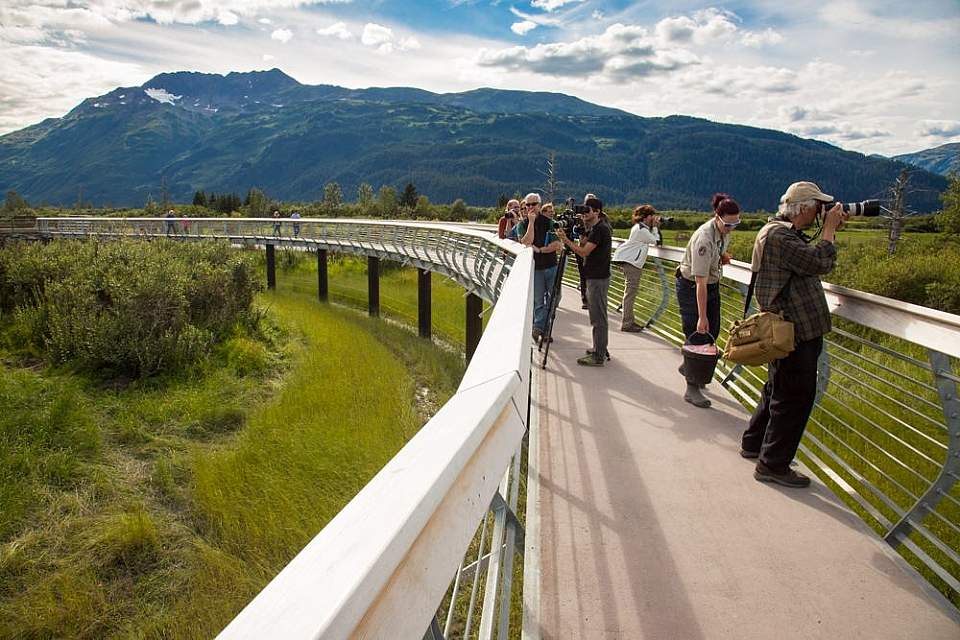
See moose up close at the Alaska Wildlife Conservation Center, a home for orphaned and rescued moose
Guaranteed Moose Viewing
Even though Alaska has gobs of moose, catching sight of one on demand can be elusive, especially during summer when the big animals tend to go deep into the brush. (Alaskans will joke that the surefire way to see a moose is to just stop trying, and then you’ll run into two nibbling on trees down the street.) But if you don’t mind viewing moose under human care, you’re always in luck.
Alaska Zoo in Anchorage
Moose are among the most popular denizens of the zoo, rescued or orphaned animals that live in the zoo’s moose habitat. 4731 O'Malley Road in South Anchorage.
Alaska Wildlife Conservation Center
Several rescued or orphaned moose live out their lives in a large outdoor enclosure on the 140-acre facility’s 1.5-mile driving or walking loop. Mile 79 of the Seward Highway in Portage, near the head of Turnagain Arm.
General Advice
- Moose tend to ignore people, but they will react with aggression if approached too closely. Stay back at least 50 feet and pay attention to their behavior. Carry binoculars and telephoto lenses so you’re not tempted to press your luck. Moose can be dangerous.
- Follow these precautions when you come face-to-face with a moose. Give even more space to a cow with calf in the spring, or an antlered bull in the fall.
- Keep dogs away—in the vehicle or left at home. Many moose react to barking dogs by charging and kicking, as though approached by wolves.
- An agitated and potentially dangerous moose will signal its mood with flattened ears, ruffled neck fur, mouth working or drooling, stomping or kicking. Back off and retreat!
- Be alert for their unpredictable appearance while driving highways or hiking in the hills. It’s especially common to see them foraging along those ecotone boundaries between wood and wetland.
- Spring and summer finds them feeding on lush greenery, sometimes hidden in jungled areas (especially cows and their newborn calves.) Excellent swimmers, moose frequently wade into ponds and lakes to munch aquatic plants.
- Some of the best moose viewing occurs outside of the traditional visitor season. Fall heralds the rut, when bulls will pursue cows into open country. Winter concentrates the animals near stands of willow and birch browse, identifiable because the trees have often been “pruned” into stunted bonsai-like forms.
- Moose can become easiest to glimpse after snow drives them into windswept areas—or into the neighborhoods of Anchorage, Fairbanks and other communities where the walking becomes easier.
- Note that moose are not usually present in the open tundra, on many islands and in rain forest habitat (especially coastal Southeast Alaska and Prince William Sound.)
For More Information
- A moose PDF from ADFG’s Wildlife Notebook Series
- Moose viewing advice from Alaska biologists
- Moose lore and management in Alaska
- Thoughts on “moose courtesy”
- How to react to an aggressive moose—advice from state biologists
- A fun, 12-minute moose safety video produced partly by kids
Show Map
Moose Viewing Spots
Anchorage Area
This 134-acre park is set in the woods where, in 1964, an entire neighborhood slid into the ocean during last century’s most powerful earthquake. The earthquake was measured at a 9.2 on the Richter scale and lasted 4 minutes. Today, this tragic event is commemorated in Anchorage’s Earthquake Park, where you’ll find signs explaining the circumstances of the quake and its effect on the area.
The Alaska Zoo started in 1966 with one baby elephant named Annabelle that was won in a contest. Since then, it has expanded to include over 77 animals across 25 acres of the Anchorage hillside.
In one of the most extraordinary wildlife spectacles in Alaska, dozens of moose converge on the brushy upper valley of the South Fork of Campbell Creek every fall during moose-mating season. This annual rut in Chugach State Park draws an amazing number of these large animals into the open.
Moose thrive in the open birch-spruce forest and willow thickets of Kincaid Park in the southwestern corner of the Anchorage peninsula. With more than 70 miles of trails crisscrossing its rugged 1,500 acres, Kincaid makes it easy for people to get deep into the woods where moose hang out.
A great winter viewing opportunity! Moose regularly congregate in this immense, brushy wetland that sprawls at the head of Knik Arm, 30 to 35 miles north of Anchorage. The 28,000-acre refuge has excellent habitat for moose.
The Twentymile and Placer river valleys reach for miles into open country visible from the Seward Highway at the head of Turnagain Arm. The five-mile-long valley along Portage Glacier Road — with its many trails, ponds and pullouts — also coaxes moose into the open for reliable viewing.
Moose can be spotted frequently in and around Potter Marsh, a 564-acre fresh pond and wetland complex on the outskirts of Anchorage. This rich habitat may be more well-known for migratory and nesting birds, but moose are regular visitors in all seasons.
Denali National Park
The best spots to see moose near the entrance of Denali National Park, and along the 92-mile Denali Park Road.
Fairbanks & Interior
Accessed via the 1.5‑mile long Lost Lake Trail, Moose Lake is an excellent place to visit with a camera or binoculars. Knock-kneed moose are a frequent visitors to the area and you’re most likely to see them if you arrive early in the morning or about an hour before sunset.
Thousands of moose forage in the river valleys surrounding Fairbanks, but can it can be challenging to catch sight of one on demand, especially during the green season. The paved Chena Hot Springs Road runs about 60 miles up the Chena River valley to the hot springs resort and offers the best shot at catching a moose in their element.
Kenai Peninsula
Located on the shores of Upper Trail Lake, the town is surrounded by the Chugach National Forest and is also home to the start of the Iditarod trail, which was blazed through here in 1910. Since it seems to be just a dot on the road, though, it would be easy to miss — but it makes a great home base for visiting Seward or the Russian River fishing area.
Sounds Wild: Pond-Bottom MooseThe wetlands where the Kenai Spur Highway crosses Beaver Creek are great for viewing moose in the early morning or late evening. Like most streams on the Kenai Peninsula, the streamside vegetation consists of willows- a favorite food of moose. Look to your right as you head toward Kenai and check out all the wetland areas for the next couple of miles.More Information ...more
The Kenai River meanders through a sweeping salt marsh and wetland on its final five-mile journey to its mouth on Cook Inlet. While more well known for its immense flocks of migrating birds and the presence of a small herd of caribou, the estuary also draws moose into the open.
Wildlife regularly converges on this shallow and very productive lake surrounded by big, open slopes in the heart of the Kenai Mountains. Famous for attracting waterfowl and migrating birds,Tern Lake also draws moose to the boundaries between meadows and forest, especially early and late in the day.
Inside Passage
The Beach Trail departs from Glacier Bay Lodge in Gustavus and follows the shore for one mile, traversing beach meadows and forest habitats, home to porcupines, bears and moose.
Humpback whales, sea otters and harbor seals are scattered throughout the Beardslees, with whales and otters most likely to be seen on the western side of the islands — nearest to open water. Watch the shore for black bears and moose. Black oystercatchers – black shorebirds with bright red-orange bills – nest on the islands. Look for harlequin ducks, pigeon guillemots, pelagic cormorants, arctic terns, marbled murrelets and large flocks of ...more
Nome
A range of wildlife inhabits the boreal forests, brushy foothills and extensive tundra. What makes Nome so extraordinary among many remote Alaska communities is its extensive gravel road system. Three different highways reach up the coast and into the peninsula’s wild interior. Renting a vehicle during summer into fall seasons enables visitors to explore sub-Arctic country that would ordinarily be extremely difficult or very expensive to access. ...more
Off the Beaten Path
This river originates from the Lakina Glacier and the southern flanks of Mt. Blackburn, spilling into the Chitina River several miles downstream. Pulling over to the side of the road just after the bridge at milepost 44, one can explore upstream for around a half-mile before getting boxed out by the forest and a narrowing of the river.
Moose are not abundant in the Blackstone uplands but they are sometimes seen feeding in this small lake. The abundance of shrubby willows around the lake and along the Blackstone River provide a good place for moose to eat and hide.This may also be your first chance to see waterfowl in the uplands. Watch for northern pintail, american widgeon, northern shoveler, harlequin duck and many others. Also watch for a variety of songbirds like… ...more
Located at Mile 17 of the Copper River Highway. An accessible boardwalk leads visitors to stunning views of both the expansive wetlands of the Copper River Delta and the surrounding mountains. A wide variety of wetland animals including trumpeter swans, moose, brown bear, and shorebirds can be seen in the area, especially during the spring and fall. The first half of this trail is paved with geoblock, so that it does not have a negative… ...more

